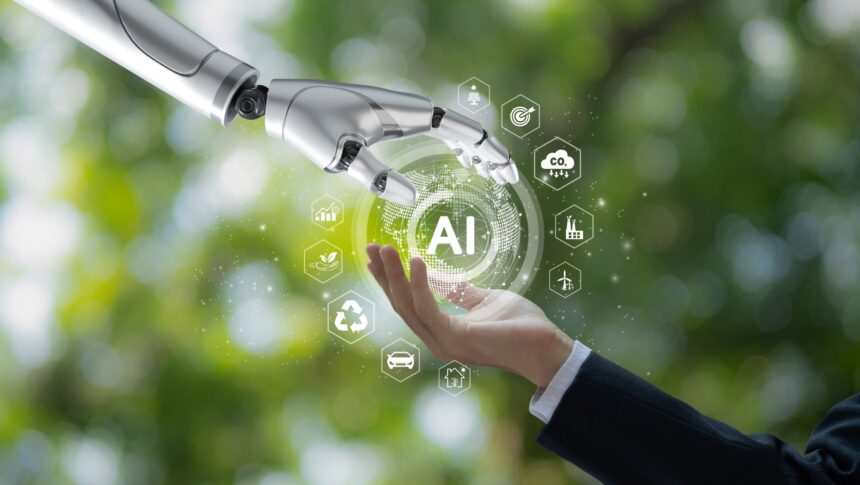The world today presents us with a compelling paradox. On one hand, we’re navigating a golden age of technological advancement, with AI rapidly becoming a fundamental force, reshaping industries and daily life.
On the other, we are face-to-face with a planet in peril rising temperatures, extreme weather, and the relentless erosion of biodiversity.
The question that defines our era isn’t simply how to advance technology, but how to effectively wield it to secure a livable future.
This brings us to a radical and increasingly urgent idea: what if the key to a sustainable planet isn’t a new, proprietary invention, but the collaborative power of openly sharing what we’ve already created?
What if the secret to a more sustainable future lies not in more AI development behind closed doors, but in the widespread, open access to the AI strategies that already exist?
The traditional model of technological progress is rooted in fierce competition. Companies and nations pour billions into research and development, treating every breakthrough as a proprietary secret a competitive edge to be guarded at all costs.
But in the face of a shared global threat like climate change, this paradigm seems critically outdated. Climate change doesn’t respect corporate firewalls or national borders it is a collective challenge that demands a collective solution.
In the world of AI, where monumental breakthroughs are built upon the foundational work of others, the concept of open collaboration holds immense, transformative power. By democratizing access to powerful AI models and strategies, we can dramatically accelerate our collective ability to address the climate crisis.
The Promise of AI in Environmental Stewardship
The potential of AI to serve as a powerful tool for environmental sustainability is no longer a futuristic fantasy; it’s a tangible reality playing out across various sectors.
From optimizing resource consumption to modeling complex ecological systems, AI is already helping us tackle some of our most pressing environmental challenges with precision and scale.
One of the most immediate and impactful applications of AI is in the energy sector. Our current energy grids are often inefficient, with a significant amount of power lost in transmission and a persistent struggle to balance supply with often unpredictable demand.
AI-powered smart grids are fundamentally changing this dynamic. By analyzing real-time data from millions of sensors, AI can predict energy demand with incredible accuracy.
This predictive capability allows utility companies to optimize power generation and distribution, drastically reducing waste and ensuring a more stable and efficient supply.
For example, AI can anticipate a spike in energy use on a sweltering summer afternoon and automatically divert power to prevent brownouts, all while minimizing the reliance on fossil fuel “peaker plants” that are fired up to meet sudden demand.
The global supply chain is another massive contributor to carbon emissions, from the fuel burned by ships and trucks to the extensive waste generated by inefficient logistics. Here, too, AI is revolutionizing operations by creating smarter, leaner supply chains.
AI algorithms can analyze a vast array of factors from real-time traffic patterns and weather forecasts to shipping container availability to optimize delivery routes, dramatically reducing fuel consumption and associated emissions.
But the impact extends beyond transportation. AI is also tackling the colossal problem of food waste, a major source of greenhouse gases.
Companies are leveraging AI to forecast consumer demand more accurately, ensuring that grocery stores order just the right amount of produce, thereby reducing the staggering amount of food that spoils and goes to waste.
Beyond industry, AI is a game-changer for scientific understanding. Climate scientists are now using sophisticated machine learning models to analyze colossal datasets on atmospheric conditions, ocean currents, and historical climate patterns.
These AI models can process this information faster and with greater nuance than traditional methods, leading to more accurate predictions of sea-level rise, the frequency of extreme weather events, and the spread of climate-sensitive diseases.
This advanced foresight allows governments and organizations to prepare for and respond to these challenges more effectively, from building resilient infrastructure to planning humanitarian aid.
Furthermore, the power of AI is extending to the animal kingdom, where conservationists are deploying it to protect endangered species. For example, remote cameras in national parks, equipped with AI-powered computer vision, can automatically identify and count different species of animals, helping researchers monitor population health without intrusive human presence.
In the critical fight against illegal poaching, AI can analyze audio from microphones in remote forests to detect the distinct sound of chainsaws or gunshots, alerting rangers in real-time and providing a crucial advantage in the race against time.
The Case for Open Collaboration: Why Share AI?
The examples above are just a glimpse of what’s possible, but most of these groundbreaking applications are developed by private companies or well-funded research institutions. The intellectual property is often locked away, accessible only to those who can afford it.
This is where the argument for open collaboration becomes not just compelling, but absolutely critical. Imagine if the AI model that optimizes a global shipping company’s logistics was an open-source tool, available to any company, large or small, anywhere in the world.
The collective reduction in carbon emissions would be exponentially greater than if only one company reaped the proprietary benefits.
The benefits of sharing AI for sustainability are multifold. First, there’s the undeniable factor of accelerated progress. When brilliant minds from around the globe can openly build upon each other’s work, innovation happens at a blistering pace.
Instead of ten different teams building similar AI models from scratch, they can all start from a shared, robust foundation, dedicating their time and expertise to refining and specializing the technology. This model fosters a virtuous cycle of improvement and innovation.
Second, it promotes the democratization of technology. Many of the regions most vulnerable to the impacts of climate change, such as developing island nations or drought-prone agricultural communities, lack the resources to develop their own sophisticated AI systems.
Open-source AI would give them direct access to the same powerful tools used by large corporations, enabling them to build resilient infrastructure and manage resources more effectively without having to reinvent the wheel.
Ultimately, this is about aligning our technological progress with our collective well-being. Climate change is a shared enemy the ultimate “Tragedy of the Commons.” Solving it requires a shared, collaborative effort that transcends corporate and national interests.
By treating AI solutions for sustainability as a global public good, rather than a private asset, we can ensure that our most powerful tools are being used to serve the greatest good. Of course, this isn’t a simple proposition.
There are valid concerns and challenges that must be addressed, from data privacy issues to the economic disincentives for companies to share their competitive edge. These are crucial discussions we must have as we build the framework for a more open future.

